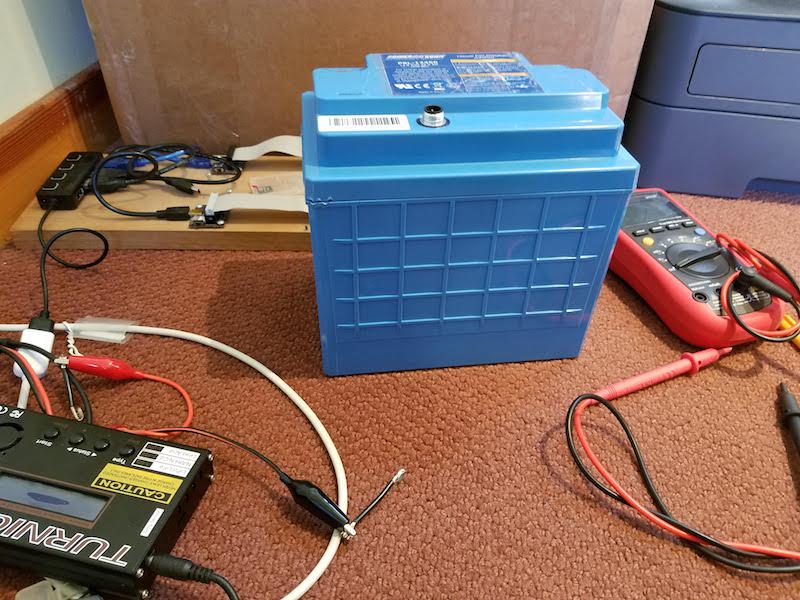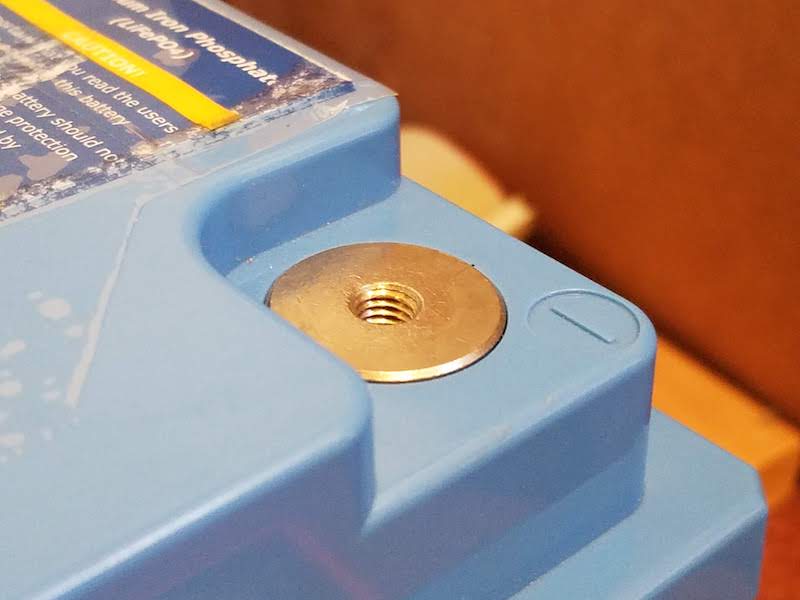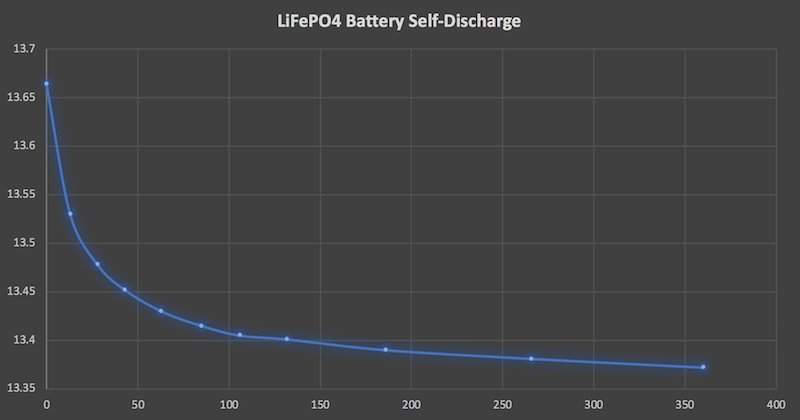Used Lithium Battery Mysteries

My used LiFePO4 battery (lithium iron phosphate) arrived yesterday. Who buys used batteries? I do, apparently. I’ve been putting the battery through its paces to see how much of the original capacity of 45 Ah / 675 Wh still remains. Unfortunately it looks like my battery may be a dud.
Where are the Battery Terminals?
My first challenge was simply connecting anything to the battery terminals. This battery is supposed to use female threaded button terminals, which are basically just M6 x 10mm steel bolts that screw into the battery, but they weren’t included. The only thing I have to work with are 6mm female threaded openings. For taking measurements with a multimeter, I can hold the probes to the terminals, but there’s no way to make a permanent connection for charging or discharging.

With all the local stores closed and everyone in California ordered to stay home, I can’t just run out to Home Depot for M6 bolts. All of my attempts at jury-rigged connections failed. I finally had to resort to sticking a loose piece of wire into the terminal opening, but it’s a poor connection.
Battery Charging
Initially I was unable to measure any voltage at all between the battery terminals. 0 volts! I contacted the seller, who reported that the battery was at 12.8V when he shipped it a week ago. So what happened?
Knowing that the battery has an integrated BMS (battery management system), I suspected that the BMS might have disconnected the internal battery cells to protect them due to over-discharging or some other fault. From the back of a closet I dug out an old Accucel 6 battery charger from my RC aircraft days, and used it to feed in constant current at 0.5A. The battery behaved like it was charging, starting at a voltage around 10V and quickly ramping up to 11-12V. But whenever I disconnected the charger and tried to measure the open circuit battery voltage, I saw something around 6V that quickly died away to zero.
I decided that maybe I just hadn’t charged the battery enough to convince the BMS to reconnect, so I kept going. After putting about 500 mAh into the battery (about 1% of the battery’s theoretical capacity), the BMS “woke up” and I could measure a stable open circuit voltage at the terminals. I was also able to power some 12V LED light strips for about 15 minutes, until I grew bored of the test.
Something is puzzling here, though. LiFePO4 batteries have a very low self-discharge rate. They can last for months on the shelf. If my battery was at 12.8V last week, it shouldn’t have dropped so far in a week to engage the BMS low-voltage cutoff of 10V or less. Hmm.
I continued charging the battery with my Accucel 6, now at a current of 3.8 amps. All went well for a few hours, and I put about 13 Ah into the battery, which should be about 25-30% of its capacity. But then the voltage quickly shot up to around 14.2V and the Accucel aborted with a “connection break” error. I checked all the connections, and tried to resume charging several times, but kept getting “connection break” or “over voltage” errors. The battery wasn’t actually over voltage, and the spec sheet says to use constant current until the voltage reaches 14.6V, then hold that voltage until current decreases to 1 amp.
No matter what I tried, I couldn’t get the battery to charge any further. Connection problem? Charger problem? Battery problem? Starting from a dead battery, it can’t have been full already after putting in only 13 Ah. Perhaps my poor terminal connection is the cause. Or maybe it’s the Accucel 6, which at 3.8 amps and 14.2 volts is operating beyond its 50 watt rating. Or maybe it’s the 15 volt power supply for the Accucel 6. I’m not sure whether it uses DC-to-DC conversion to enable charging batteries at a voltage higher than the supply voltage.
Without a way to reliably charge the battery to 100%, I can’t do a discharge test, so I can’t measure the capacity of the battery.
Self-Discharge
Defeated for the moment, I gave up on charging and disconnected the charger. I measured the open circuit voltage at 13.664V, or 3.416V/cell. According to the state of charge table for LiFePO4 cells, that indicates it was more than 90% charged, close to 100%. But how could that be, after starting from zero and only putting in 25-30%? A few minutes later I measured the voltage again, and it had dropped a tenth of a volt. Even with nothing connected to the battery, the voltage kept dropping over the next few hours:
| initial reading | 13.664 V |
| 13 minutes | 13.530 V |
| 28 minutes | 13.478 V |
| 43 minutes | 13.452 V |
| 63 minutes | 13.430 V |
| 85 minutes | 13.415 V |
| 106 minutes | 13.405 V |
| 132 minutes | 13.401 V |
| 186 minutes | 13.390 V |
| 266 minutes | 13.381 V |
| 360 minutes | 13.372 V |
Divide these numbers by 4 to get the cell voltage, and compare them to this LiFePO4 SOC data. Is this normal? Maybe I need to wait a few days to see how much further the voltage drops, before I can be sure.

I’m guessing this battery may have an internal short circuit somewhere that’s causing it to discharge even when it’s sitting unused and disconnected. This would explain why my open circuit voltage measurements are falling so quickly, and why the battery dropped from 12.8V to below the low-voltage cutoff during a week of shipping time. If I’m right, unfortunately that makes the battery a useless $167.50 lump of lithium and plastic.
Is there a better explanation here? Maybe I’ve overlooked something? If you have experience with deep cycle batteries, especially lithium iron phosphate batteries, please leave a comment and share your thoughts.
Read 2 comments and join the conversation2 Comments so far
Leave a reply. For customer support issues, please use the Customer Support link instead of writing comments.


After 21 hours it’s down to 13.349V and the rate of drop is flatlining. Based on more reading this is probably normal for a lithium battery that’s near 100% charge. This reference says lithium ion will drop 5% in the first 24 hours, then 1-2% per month after that. I’ll assume lithium iron phosphate is similar.
I’m now starting a crude discharge test using a 12W LED light. It’s crude because I don’t know exactly how charged the battery really is, but based on voltage I’m guessing it’s more than 90%. I don’t have a reliable way of connecting anything to the battery, and I can’t exactly measure the accumulated amp hours or watt hours taken from the battery. But it’s about a 1 amp draw for the light, and I’ll just see how long the light stays on until the battery dies. In theory it should last about 45 hours if the battery still has its original capacity, but I’ll be happy if I can get 35 hours or more. Stay tuned…
Stackable Integrated Battery’s most popular products in Europe in 2022
URL: https://www.essvalley.com/stackable-integrated-battery